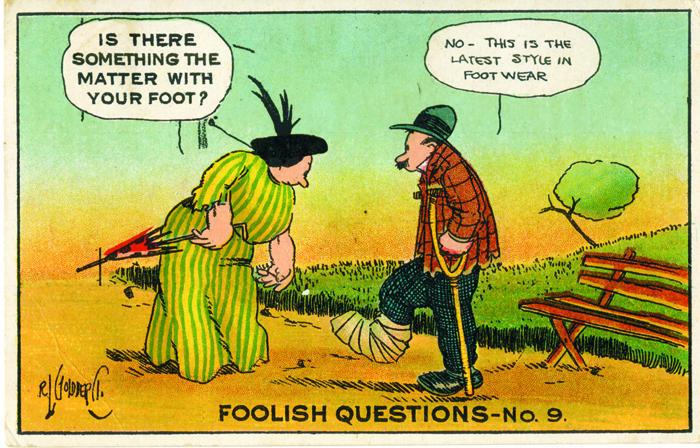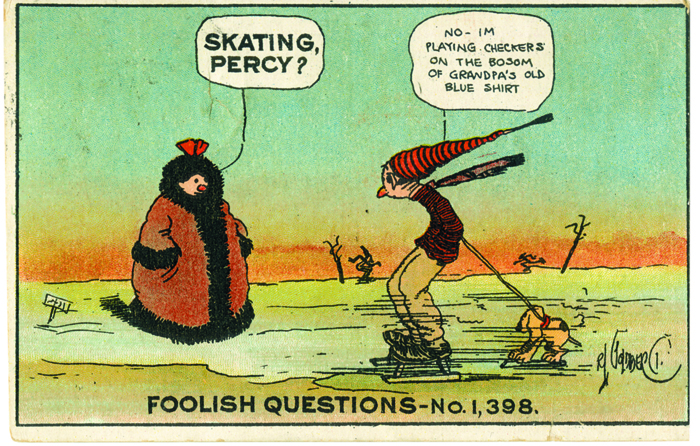The Art of Rube Goldberg
Ron Morosan
January 2020
The Art of Rube Goldberg
The Queens Museum
Flushing Meadows, Corona Park, New York
thru February 9, 2020
Rube Goldberg: Is He a Comic Genius?
This is the question I had in mind as I took the #7 train to the Mets-Willets Point stop to see a comprehensive exhibition of the widely syndicated cartoonist and humorist Rube Goldberg, on view at the Queens Museum until February 9th, 2020.
Some may ask: Who is Rube Goldberg? As one of the few people whose name is in the Merriam Webster dictionary describing a mechanical sequence of events that makes something simple, like closing a door, into a complex series of actions that are patently absurd and wildly humorous, today his name and cartoons do not get a lot of media play. Yet, his influence on other artists and filmmakers from Charlie Chaplin to Mad Magazine contributors is extensive.
In this first retrospective exhibition of Goldberg’s work since 1970, the year he died, the whole range of his long career is on display in two galleries, which even include an outstanding drawing he made at the age of eleven. Best know for his Inventions Cartoons, the elaborate cartoon illustrations of absurd chain reactions that got his name in the dictionary, he was wildly creative as a comic illustrator and through his long career worked as a vaudeville comedian, political cartoonist, comic writer, sculptor, TV show host, and commercial novelty product developer.
The Queens Museum exhibition shows a sampling of the full range and variety of his ideas and skills, from his Foolish Questions, his first big success in 1908, to his political commentary drawings from the 1940’s when he was awarded the Pulitzer Prize, and also some of his commercial forays into popular consumer novelties. Born in San Francisco in 1883 he went to college at Berkeley, received a degree in engineering, and worked for the public sewer works department of the City of San Francisco. Quickly giving this up, he improved his drawing skills and got a job as a sports illustrator at the San Francisco Sun, then later the Bulletin.
In 1907 he left the San Francisco Bulletin and chose the challenge of New York City, a place he called “the front row.” Taking a job at the Evening Mail, he quickly advanced with the success of his Foolish Questions cartoon series in which a person asks a stupid question and gets a stupid answer. By 1922 he was receiving an annual salary of close to $200,000 per year, and creating a syndicated comic strip in national newspapers that reached a million readers in ten years. Rube Goldberg was then a household name.
In his Inventions Cartoons he used characters who appeared frequently, like Professor Lucifer Gorgonzola Butts. (Rube Goldberg’s official birth name is Ruben Lucious Goldberg, so Professor Butts is assumed to be an anagram.) The Butts character is always involved in being stupid or making others look stupid. “Stupid” is a constant feature of all the Invention Cartoons and also the Foolish Questions, for who else but a stupid person would make something simple, like closing a door, into a complex action?
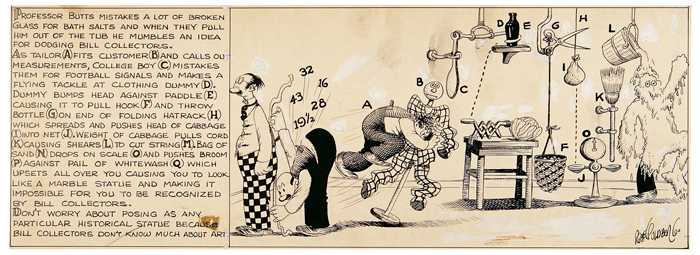 Idea for Dodging Bill Collectors
Idea for Dodging Bill Collectors
In one of his most reproduced Invention Cartoons we see Professor Butts swinging a golf club under an apple tree and setting off the sequence of chain reactions that should help the golfer sink the ball. (Goldberg was an avid golfer.) In an incredibly crisp drawing style we see a mastery of drawing techniques ranging from realism In the apple tree and club house in the distance, to the precisely drawn comic characters, the caddy and Professor Butts. These are simple goofy looking characters with clumsy positions and comical walking styles. (The caddy’s walk must have influenced the gait of the character in the original cartoon series Smurfs and also the Mr. Natural of R. Crumb.)
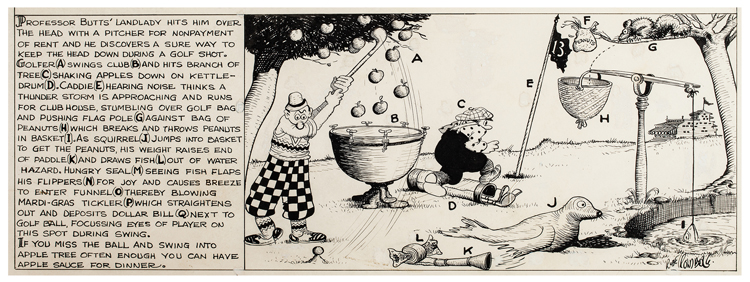 Professor Butts Golf Shot
Professor Butts Golf Shot
In the staging of a Goldberg cartoon the situation is drawn to make the viewer see that the whole cartoon is a “put-on,” a deliberate humor that is funny by making something look serious but in fact is absurd. The idea of the put-on is relatively new in humor of the first decades of the twentieth century, and we see more of it later in Chaplin, Keaton, and then later in Mad Magazine. Mel Brooks is the master of put-on humor with masterpieces of film like Blazing Saddles and The Producers with its “Spring Time for Hitler” musical. Goldberg paved the way for this kind of thinking about the humorously absurd.
The Queens Museum exhibition also includes political drawings from the 40’s in which Goldberg used ink and charcoal to produce somber and incisive commentaries on the disturbing events in the world. His 1947 drawing of Jews and Arabs is still accurate today; we see two trench-like roads parallel but not joining, with a figure of a Jew and an Arab walking together, but divided. The following year he would win the Pulitzer Prize for his drawing depicting the perilous situation of atomic war: a giant bomb is balanced on a cliff with a small home on top of it.
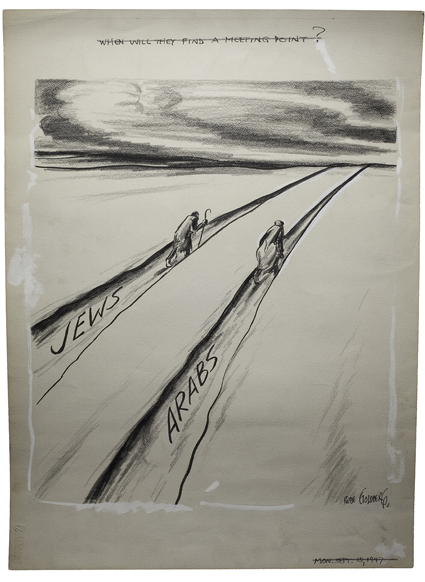 When Will They Find a Meeting Point
When Will They Find a Meeting Point
In the 1930’s Goldberg flirted with the West Coast and Hollywood, but quickly realized his soul was on the east coast. At this time he ventured into new areas like novelty product design with a series of comic whisky bottle stoppers called Boob Bottle Stoppers. Then he tried his hand at comic travel book design with Rube Goldberg’s Guide to Europe. Later he even did a TV show where he talked about ideas and drew cartoons in front of the camera.
In walking through the many parts of this exhibition one becomes aware of the incredible influence Rube Goldberg has had on other artists, film makers, humorists, and the public in general. He was a prime “idea man.” A video in the exhibition shows the scene in Charlie Chaplin’s Modern Times of the character working on a production line and being fed by a Goldberg-like apparatus. Other film influences are shown on another monitor: Flubber and Back to the Future have Goldberg chain event sequences included.
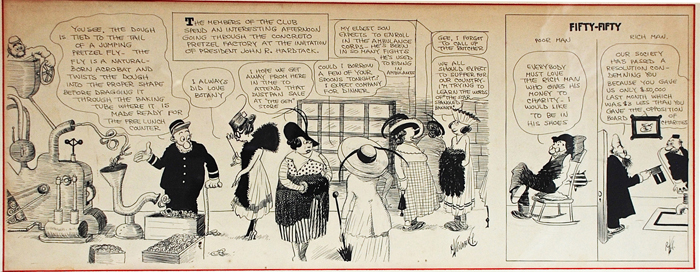 Fifty-Fifty, Pretzel Factory
Fifty-Fifty, Pretzel Factory
In the art historical context it is important to mention the tremendous influence Goldberg had on Dada artists like Marcel Duchamp and Man Ray. In 1921 these artists produced a single copy of a publication called New York Dada. On the third page is a reproduction of a Rube Goldberg Invention Cartoon in which we see five professors demonstrating how to prove that if a bullet is fired into a pipe with many curves it will go around corners and come out the end. Unfortunately, a tied up young boy is at the end and will be shot in the head. Cruel, but this is pure Dada with the message that cruelty can be fun.
This brings up the issue of funny in Goldberg. In fact, a lot of Goldberg is not belly laugh funny. Rather, it is intellectual funny, because it is philosophical and shows the weaknesses and foibles of human beings.
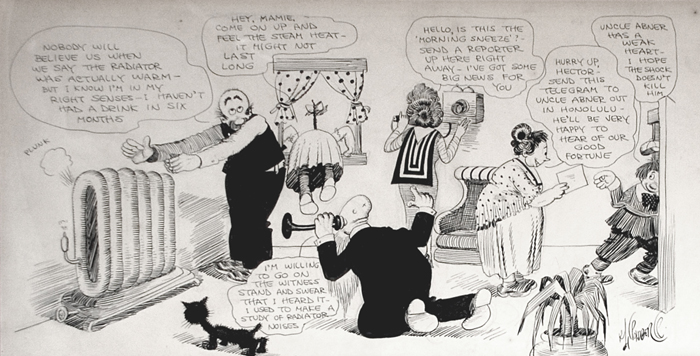 Their First Steam Heat
Their First Steam Heat
Was Rube Goldberg a genius? In his way he was a self styled “idea man” at a time when that quality was not widely recognized as a mode of thought. He exhibited the capacity to invent himself in multiple ways, almost at will. His Invention Cartoons were more than cartoons: they were the equivalent of thought experiments, operations that the viewer had to visualize, and they were wildly original. He was a pioneer in the domain of cartoon humor and improvisational comic thought that is still leaving an impression.
Photo credit: Jennifer George
Legacy Director Rube Goldberg Inc.
Ron Morosan is an artist, writer, and curator. He has shown his work internationally at the American Pavilion of The Venice Biennale and the Circulo De Bellas Artes in Madrid, Spain. In the US he has shown at the New Museum and had a one-person exhibition at the New Jersey State Museum, and at numerous galleries in New York. He curated the Robert Dowd exhibition, Subversive Pop, at Center Galleries in Detroit, as well as Denotation, Connotation, Implication at Eisner Gallery, City University of New York. He has written catalogues for many artists, including Enid Sanford, Tom Parish, Robert Dowd, and others. In the 1990’s he started and ran B4A Gallery in Soho, New York, writing press releases, articles, and catalogues.

